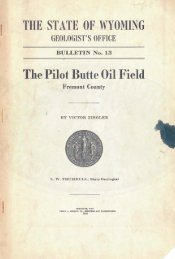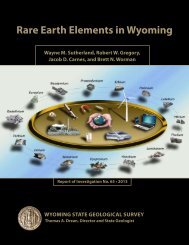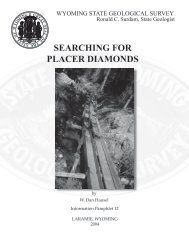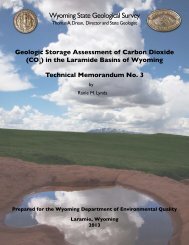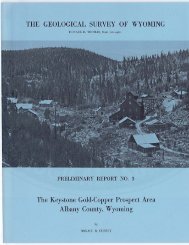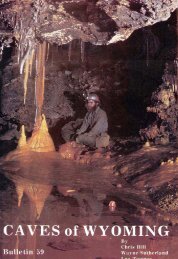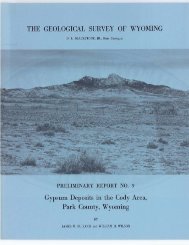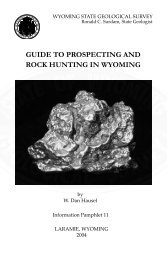The Dinosaurs of Wyoming - Wyoming State Geological Survey ...
The Dinosaurs of Wyoming - Wyoming State Geological Survey ...
The Dinosaurs of Wyoming - Wyoming State Geological Survey ...
You also want an ePaper? Increase the reach of your titles
YUMPU automatically turns print PDFs into web optimized ePapers that Google loves.
"SACRAL BRAIN" OF DIi\TOSAURS<br />
depart to the limbs. That this is the \\"hole significance <strong>of</strong> these<br />
two enlargements in Stegosaurus and also in other dinosaurs<br />
I have no doubt, and the relative size <strong>of</strong> each dilatation bears<br />
an approximate ratio to that <strong>of</strong> the limbs innervated, plus in the<br />
hinder pair the huge caudo-femoral and other muscles which<br />
actuated the tail.<br />
"I still feel, despite the contention <strong>of</strong> the German writers,<br />
that the 'sacral brain'-which should not be called by such a<br />
term-possessed no unusual function whatever, but only the<br />
normal one <strong>of</strong> transmission and reflex action in an unusual<br />
degree, and that to invoke any new and unknown function as<br />
a reason for its relatively immense size, especially one connected<br />
with digestive efficiency, is not justified by the evidence at hand.<br />
"Branca further says: 'We may also think <strong>of</strong> these animals<br />
as sluggish in habit, in consequence <strong>of</strong> which much less food<br />
was required than is the case in an active animal.' On the<br />
other hand, in warm-blooded animals the largest species occur<br />
in cooler climates, beoause large animals have 'a relatively<br />
smaller radiating surface than smaller ones, a factor <strong>of</strong> the<br />
greatest importance in the regulation <strong>of</strong> body warmth.' To the<br />
first statement I can take 110 exception. <strong>The</strong> second, however,<br />
gives food for thought. In the first place, is it an invariable<br />
rule that the largest species <strong>of</strong> warm-blooded animals occur in<br />
cooler climates? <strong>The</strong> present-day distribution <strong>of</strong> the elephant,<br />
hippopotamus, and rhinoceros does not bear this out, and even<br />
in the Pleistocene the largest elephants, such as Elephas imperator,<br />
were southern forms compared with the smaller, coldadapted<br />
E. primigenius. With marine creatures Branca's statement<br />
seems more nearly true, for the walrus and huge seaelephants<br />
are both adapted to cold waters, and the same is true<br />
<strong>of</strong> the right whales, Balaena mysticetus and B. australis. <strong>The</strong><br />
sperm whale, on the other hand, is tropical or subtropical, not<br />
occurring, except accidentally, in the polar regions (Flower<br />
and Lydekker), while the great rorquals (Balaenoptera) are<br />
found in all seas except the Arctic and probably the Antarctic<br />
also. Of the deer, perhaps the largest living form is the Alaskan<br />
moose, while no bears in existence can compare in magnitude<br />
with the great Kadiak bear <strong>of</strong> the same region. But this<br />
argument loses weight if the dinosaurs were not warm-blooded,<br />
and though the supposition that they were has been advanced,<br />
it is not susceptible <strong>of</strong> pro<strong>of</strong>. It is within the range <strong>of</strong> possibility<br />
that the temperature <strong>of</strong> the more agile dinosaurs rose<br />
appreciably during the time <strong>of</strong> their activity, as in many <strong>of</strong> the<br />
so-called cold-blooded (poikilothermous) creatures today, but<br />
whether or no any dinosaurs had a mechanism for even a partial<br />
maintenance <strong>of</strong> temperature is unknown. If their bodily heat<br />
varied with that <strong>of</strong> the surrounding air, the greater bulk and<br />
hence relatively smaller radiating surface would render them<br />
less susceptible to rapid temperature changes, and thus prolong<br />
their time <strong>of</strong> activity by tiding over a brief drop in temperature,<br />
but would hardly be available in an extended cooler period.<br />
That increase <strong>of</strong> size in dinosaurs was an adaptation for the<br />
conservation <strong>of</strong> energy, and in this way reduced the relative<br />
amount <strong>of</strong> nourishment necessary for their maintenance, seems<br />
hardly probable."<br />
63




